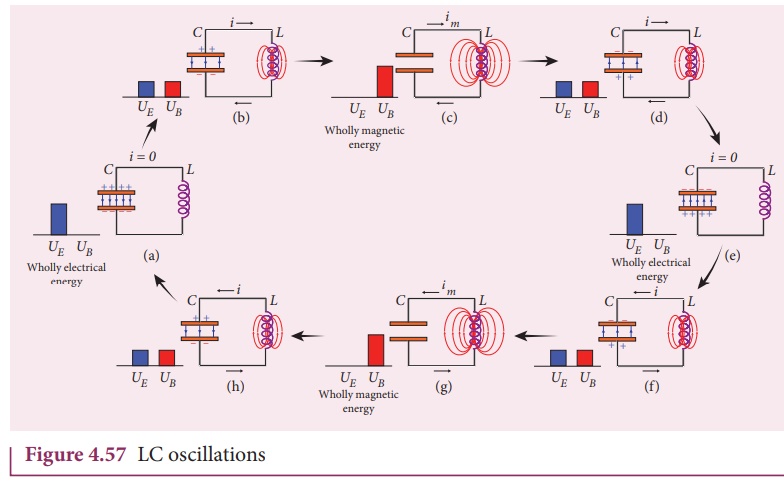Chapter: 12th Physics : Electromagnetic Induction and Alternating Current
Energy conversion during LC oscillations

Energy conversion during LC oscillations
We have learnt that
energy can be stored in both inductors and capacitors. In inductors, the energy is stored in the form of magnetic field while
in capacitors; it is stored as the electric field.
Whenever energy is given
to a circuit containing a pure inductor of inductance L and a capacitor
of capacitance C, the energy oscillates back and forth between
the magnetic field of the inductor and the electric field of the capacitor.
Thus the electrical oscillations of definite frequency are generated. These
oscillations are called LC oscillations.
Generation of LC oscillations
Let us assume that the
capacitor is fully charged with maximum charge Qm at the
initial stage. So that the energy stored in the capacitor is maximum and is
given by UE=Q2/2C. As there is no current in the
inductor, the energy stored in it is zero i.e., UB = 0. Therefore, the total
energy is wholly electrical. This is shown in Figure 4.57(a).
The capacitor now begins
to discharge through the inductor that establishes current i in
clockwise direction. This current produces a magnetic field around the inductor
and the energy stored in the inductor is given by UB = Li2
/2 . As the charge in the capacitor decreases, the energy stored in it also
decreases and is given by

At that instant, the total energy is the sum of electrical and magnetic energies
(Figure 4.57(b)).
When the charges in the
capacitor are exhausted, its energy becomes zero i.e., UE = 0 . The energy is
fully transferred to the magnetic field of the inductor and its energy
is maximum. This maximum energy is given by UB=LI m
2/2 Where Im is the maximum current flowing in the
circuit. The total energy is wholly magnetic (Figure 4.57(c)).
Even though the charge
in the capacitor is zero, the current will continue to flow in the same
direction because the inductor will not allow it to stop immediately. The
current is made to flow with decreasing magnitude by the collapsing magnetic
field of the inductor. As a result of this, the capacitor begins to charge in
the opposite direction. A part of the energy is transferred from the inductor
back to the capacitor. The total energy is the sum of the electrical and
magnetic energies (Figure 4.57(d)).
When the current in the
circuit reduces to zero, the capacitor becomes fully charged in the opposite
direction. The energy stored in the capacitor becomes maximum. Since the
current is zero, the energy stored in the inductor is zero. The total energy is
wholly electrical (Figure 4.57(e)).
The state of the circuit
is similar to the initial state but the difference is that the capacitor is
charged in opposite direction. The capacitor then starts to discharge through
the inductor with anti-clockwise current. The total energy is the sum of the
electrical and magnetic energies (Figure 4.57(f)).
As already explained,
the processes are repeated in opposite direction (Figure 4.57(g) and (h)).
Finally, the circuit returns to the initial state (Figure 4.57(a)). Thus, when
the circuit goes through these stages, an alternating current flows in the
circuit. As this process is repeated again and again, the electrical
oscillations of definite frequency are generated. These are known as LC
oscillations.
In the ideal LC
circuit, there is no loss of energy. Therefore, the oscillations will continue
indefinitely. Such oscillations are called undamped oscillations.
Related Topics